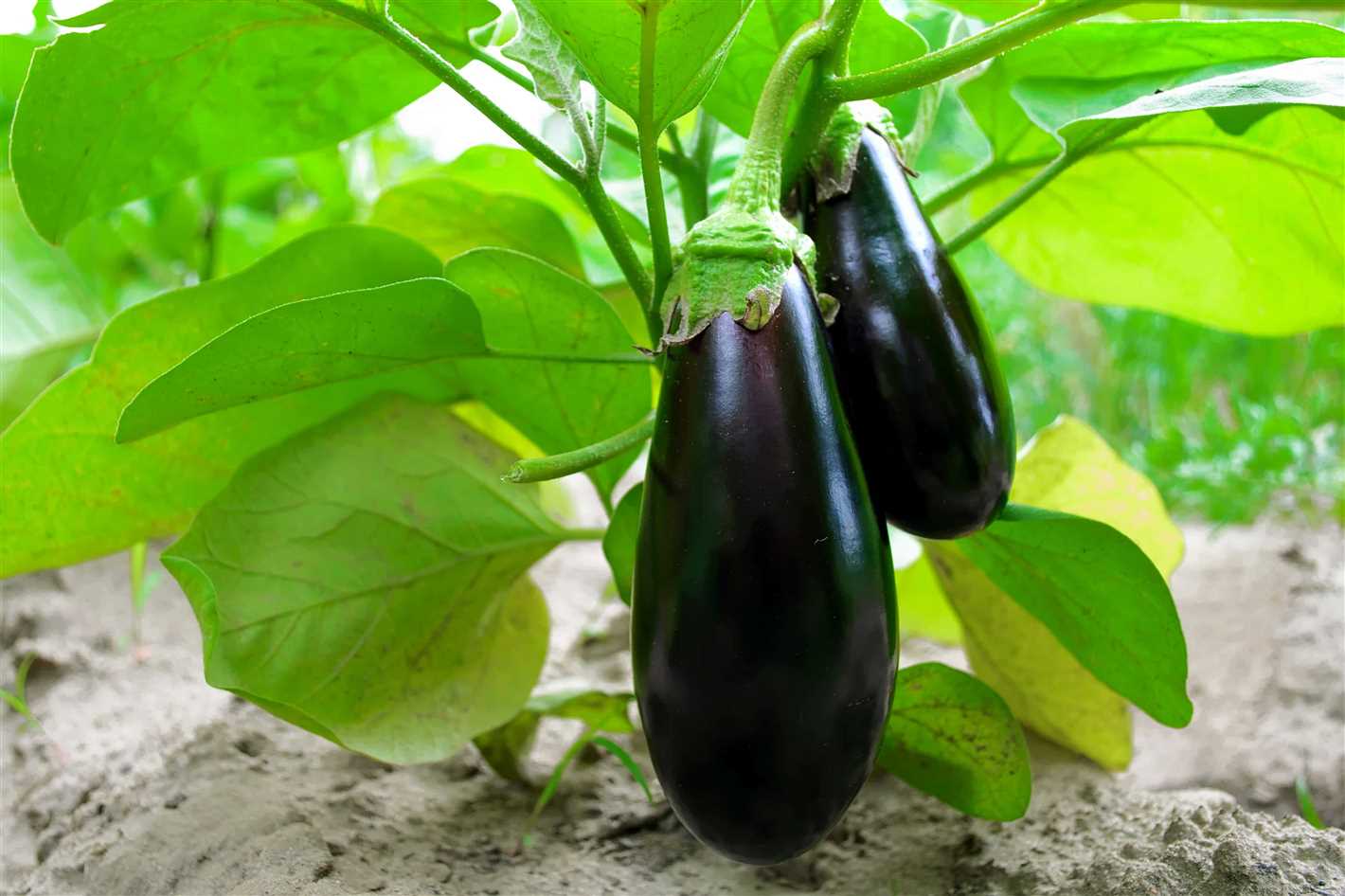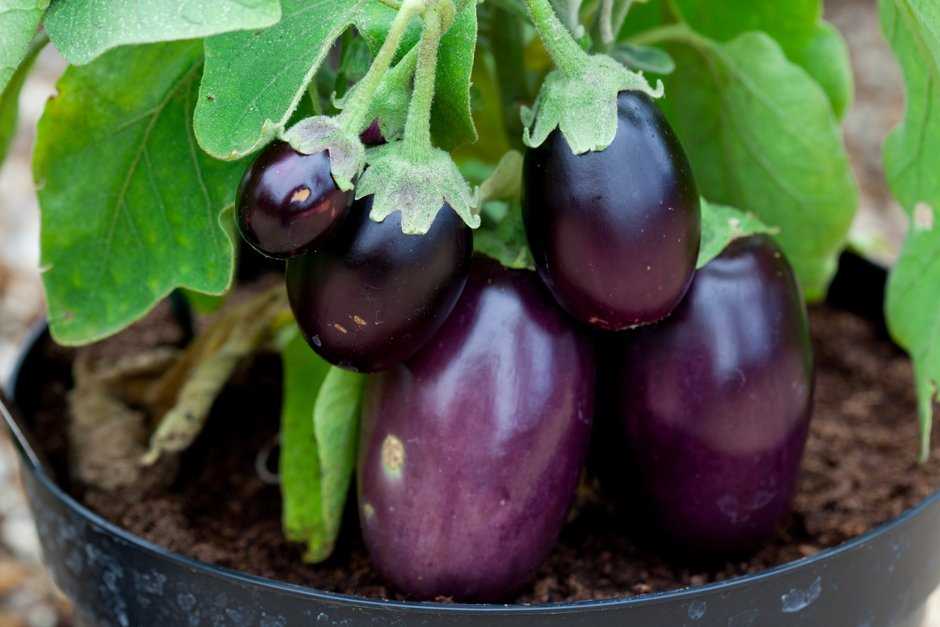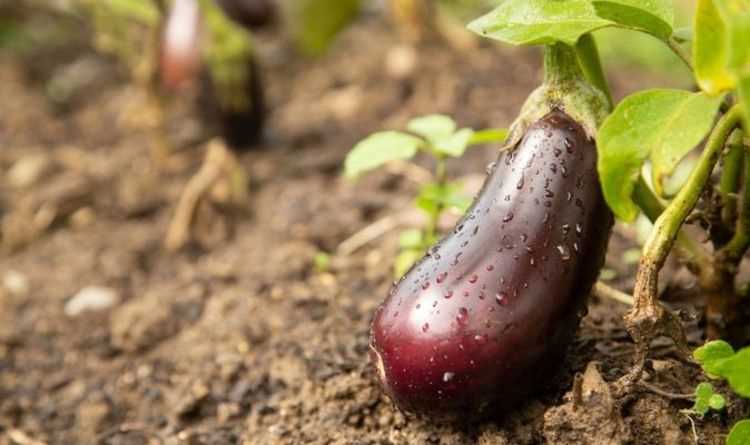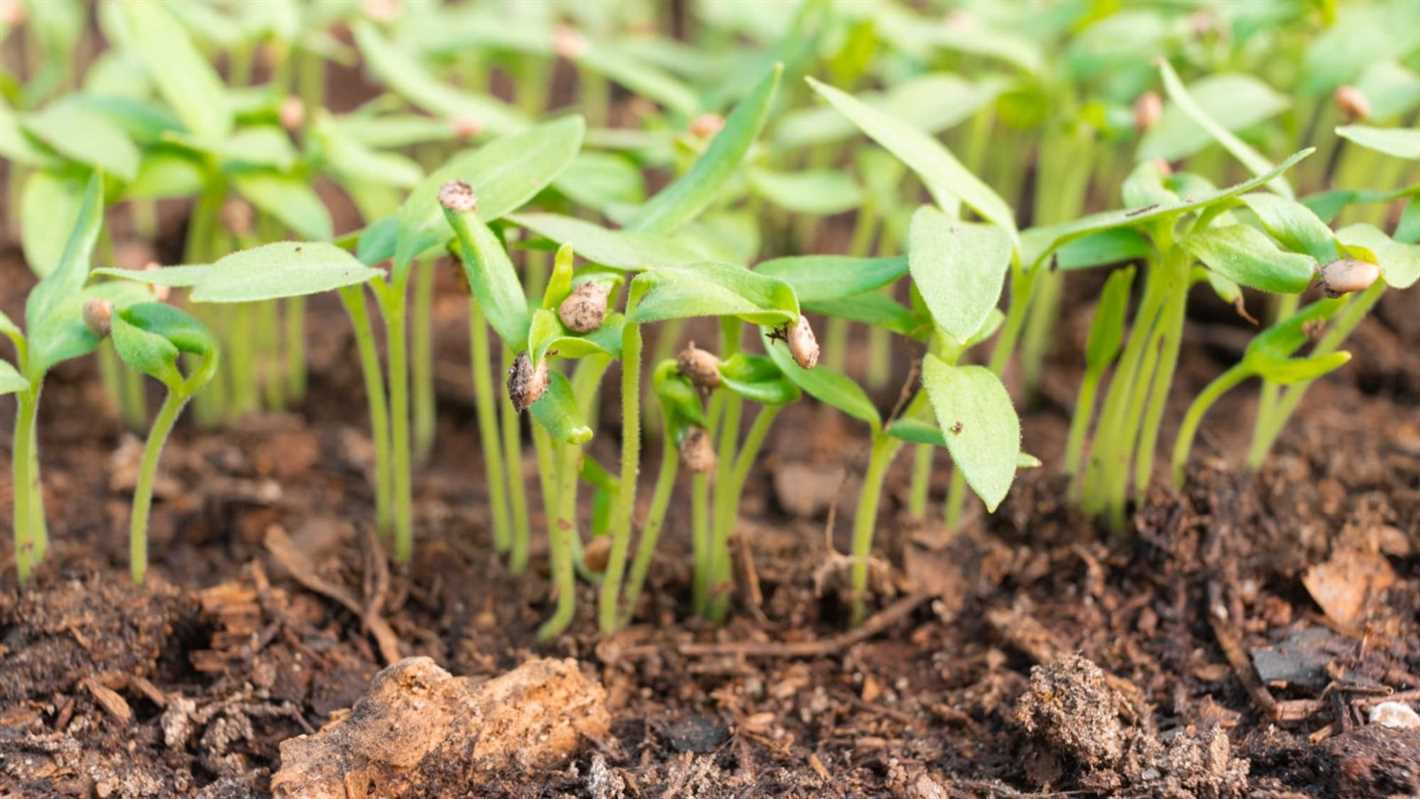- Universal Terms of Sowing Aubergines for Seedlings
- 1. Sowing Time
- 2. Seed Selection
- 3. Seed Starting Containers
- 4. Seed Starting Mix
- 5. Sowing Depth and Spacing
- 6. Germination Conditions
- 7. Light and Watering
- 8. Transplanting
- 9. Hardening Off
- 10. Transplanting Outdoors
- Suitable for Any Region
- Suitable for Any Country
- Optimal Sowing Time
- Consider Climate and Growing Season
- Soil Temperature
- Other Factors to Consider
- Preparation of Seeds
- Selection of Containers
- 1. Size
- 2. Drainage
- 3. Material
- 4. Sterility
- 5. Quantity
- 6. Labeling
- 7. Tray or Stand
- Sowing Depth and Substrate
- Temperature and Lighting
- Lighting Requirements:
- Temperature Requirements:
- Care and Transplanting
- Care:
- Transplanting:
- “Question-Answer”
- What are the universal terms for sowing aubergines for seedlings?
- When is the best time to sow aubergines for seedlings?
- What are the temperature requirements for sowing aubergine seedlings?
- How should the soil be prepared for sowing aubergine seedlings?
- Can these universal terms be applied to any country or region?
- “Video” How to Grow Eggplants – Complete Growing Guide
When it comes to growing aubergines, it’s important to start with seedlings. Sowing aubergine seeds for seedlings is a universal practice that can be done in any region and any country. By following certain terms, you can ensure successful germination and growth of your aubergine plants.
So, what are the universal terms of sowing aubergines for seedlings?
Firstly, it’s important to choose the right time to sow aubergine seeds. This typically depends on the climate of your region, but generally, it’s recommended to sow the seeds indoors about 8-10 weeks before the last frost date. This allows the seedlings to grow strong and healthy before being transplanted outdoors.
Next, it’s essential to provide the right conditions for germination. Aubergine seeds require warmth, so it’s recommended to use a heat mat or place the seed trays in a warm location. Additionally, the seeds should be planted in a well-draining soil mix and covered lightly with a thin layer of soil. Regular watering is necessary to keep the soil moist but not overwatered.
Finally, proper care should be taken during the seedling stage. This includes providing adequate light, maintaining a consistent temperature, and regular feeding with a balanced fertilizer. It’s also important to gradually acclimate the seedlings to outdoor conditions before transplanting them into the garden.
By following these universal terms of sowing aubergines for seedlings, you can ensure healthy and productive plants no matter where you are located. So, get started on your aubergine seedlings and look forward to a bountiful harvest!
Universal Terms of Sowing Aubergines for Seedlings
Aubergines, also known as eggplants, are warm-season vegetables that are perfect for growing as seedlings before transplanting into the garden. Whether you live in a tropical climate or a colder region, following these universal terms will help ensure successful and healthy aubergine seedlings.
1. Sowing Time

The ideal time to sow aubergine seeds for seedlings is 8-10 weeks before the last frost date in your region. This allows the seedlings to establish a strong root system and develop before being transplanted outdoors.
2. Seed Selection
Choose high-quality seeds from a reliable seed supplier. Look for varieties that are suitable for your climate and growing conditions. Popular aubergine varieties include ‘Black Beauty,’ ‘Ichiban,’ and ‘Gretel.’
3. Seed Starting Containers

Use clean and sterile containers to start your aubergine seeds. Suitable options include seed trays, peat pots, or trays with individual cells. Ensure that the containers have drainage holes to prevent waterlogging.
4. Seed Starting Mix
Prepare a well-draining seed starting mix by combining equal parts of peat moss, perlite, and vermiculite. This mix provides the necessary nutrients and moisture retention for seed germination and early seedling growth.
5. Sowing Depth and Spacing
Sow the aubergine seeds at a depth of 1/4 to 1/2 inch (0.6 to 1.3 cm). Space the seeds 2-3 inches (5-7.6 cm) apart in the seed starting containers to allow room for growth.
6. Germination Conditions
Place the containers in a warm and humid location to encourage seed germination. Aim for a temperature range of 75-85°F (24-29°C) for optimal germination. Cover the containers with plastic wrap or use a humidity dome to create a greenhouse-like environment.
7. Light and Watering
Once the seeds have germinated, remove the plastic wrap or humidity dome and place the containers in a well-lit area. Provide the seedlings with 12-14 hours of direct sunlight per day or use grow lights if natural light is limited. Water the seedlings regularly, keeping the soil evenly moist but not waterlogged.
8. Transplanting
Transplant the aubergine seedlings into larger containers or individual pots once they have developed their first true leaves. This usually occurs 4-6 weeks after sowing. Handle the seedlings carefully to avoid damaging the delicate roots.
9. Hardening Off
Gradually acclimate the seedlings to outdoor conditions by placing them in a sheltered location for a few hours each day. Start this process 1-2 weeks before the expected transplanting date. Gradually increase the time and exposure to direct sunlight to help the seedlings adjust to the outdoor environment.
10. Transplanting Outdoors
Choose a sunny location in your garden with well-draining soil for transplanting the aubergine seedlings. Space the plants 18-24 inches (45-61 cm) apart to allow sufficient room for growth. Water the transplanted seedlings thoroughly after planting.
By following these universal terms for sowing aubergines for seedlings, you can enjoy a successful harvest of healthy and productive plants regardless of the region or country you are in!
Suitable for Any Region
When sowing aubergine seeds for seedlings, it is important to consider the specific needs of your region. However, there are some universal terms that can be followed regardless of the region or country you are in. These terms include:
- Timing: Start sowing aubergine seeds indoors about 8-10 weeks before the last expected frost date in your region. This will give them enough time to grow into healthy seedlings before transplanting them outdoors.
- Seed Depth: Plant the seeds about 0.25-0.5 inches (0.6-1.3 cm) deep in the seed starting mix. This will provide them with enough moisture and warmth for germination.
- Temperature: Keep the seedlings in a warm environment with temperatures between 70-85°F (21-29°C). This will promote faster and stronger growth.
- Light: Provide the seedlings with 14-16 hours of light per day. If natural sunlight is not available, you can use fluorescent lights or grow lights to supplement the light requirements.
- Watering: Water the seedlings regularly, keeping the soil moist but not waterlogged. Avoid overwatering as it can lead to root rot.
- Fertilizer: After the seedlings have developed their first true leaves, you can start fertilizing them with a balanced liquid fertilizer. Follow the instructions on the fertilizer package for proper dilution and application.
Following these universal terms will help you grow healthy and vigorous aubergine seedlings, no matter where you are located. Remember to also consider the specific climatic conditions and regional recommendations for your area to further optimize the growth and yield of your aubergine plants.
Suitable for Any Country
When it comes to sowing aubergine seedlings, the universal terms and guidelines can be followed in any country. The basic principles and techniques are applicable regardless of the specific region or climate. Here are some key points to keep in mind:
- Selection of Seeds: Choose high-quality aubergine seeds that are suitable for your desired variety and growing conditions. Look for reputable suppliers or seed banks that offer a wide range of options.
- Sowing Time: The ideal time for sowing aubergine seeds may vary slightly depending on the local climate and weather patterns. However, in general, it is recommended to start sowing indoors approximately 8-10 weeks before the last expected frost date.
- Germination: Aubergine seeds require warm temperatures for successful germination. Keep the soil consistently moist and provide a temperature of around 70-80°F (21-27°C) for optimal sprouting. Using a seedling heat mat or placing the seed tray near a heat source can help speed up the germination process.
- Seedling Care: Once the seeds have germinated, provide them with ample light to promote healthy growth. Consider using grow lights or placing the seedlings near a sunny window. Maintain a temperature of around 60-70°F (15-21°C) during the day and slightly cooler temperatures at night.
- Transplanting: When the seedlings have developed a few true leaves and the threat of frost has passed, they can be transplanted into larger pots or directly into the garden soil. Ensure that the soil is well-drained and provide adequate spacing between plants to allow for proper growth and air circulation.
- Fertilization and Watering: Aubergine plants require regular feeding with balanced fertilizers to support their growth. Additionally, they need consistent watering to keep the soil evenly moist, but not waterlogged. Overwatering should be avoided to prevent root rot.
- Pest and Disease Management: Monitor the plants regularly for any signs of pests or diseases. Use organic pest control methods, such as handpicking or neem oil sprays, to combat common pests like aphids or whiteflies. Proper sanitation practices and crop rotation can help prevent the occurrence of diseases.
Following these universal terms for sowing aubergine seedlings will give you a great start, regardless of the country or region where you are located. Remember to adjust certain factors, such as sowing time, according to your local climate conditions, and seek advice from local gardening resources if needed. Happy sowing!
Optimal Sowing Time
Choosing the right time to sow aubergine seeds is essential for successful seedling growth and subsequent transplanting. The optimal sowing time may vary depending on the specific region or country, but there are some general guidelines to follow.
Consider Climate and Growing Season
The climate and length of the growing season in your region should be taken into consideration when determining the optimal sowing time for aubergines. Aubergines thrive in warm temperatures and require a long growing season to reach maturity.
In regions with a short growing season, it is advisable to start sowing aubergine seeds indoors or in a greenhouse several weeks before the last expected frost date. This allows the seedlings to develop and be transplanted outside once the weather warms up sufficiently.
In regions with a longer growing season or a mild climate, aubergine seeds can be directly sown outdoors once the soil temperature reaches around 21°C (70°F). This is typically in late spring or early summer.
Soil Temperature
The soil temperature is a critical factor for successful aubergine germination. The optimal soil temperature for aubergine seeds to germinate is between 24-30°C (75-86°F). If the soil is too cold, the seeds may not germinate or may take a longer time to sprout.
Ensure the soil has warmed up sufficiently before sowing aubergine seeds. If the soil temperature is too low, you can use various techniques like covering the soil with plastic or using a heating mat to raise the temperature and promote germination.
Other Factors to Consider

Aside from climate and soil temperature, there are a few other factors to consider when determining the optimal sowing time for aubergines. These may include:
- Local frost dates: Sowing seeds after the last expected frost date reduces the risk of frost damage to seedlings.
- Seedling development: Aim to have well-developed seedlings ready for transplanting when the weather is warm enough.
- Planting schedule: Consider the timeline for transplanting aubergines into the garden and plan the sowing time accordingly.
By taking into account these factors and observing the specific conditions in your region, you can determine the optimal sowing time for aubergine seeds. This will help ensure healthy seedling growth and maximize the chances of a successful harvest.
Preparation of Seeds
In order to have healthy and strong eggplant seedlings, it is important to properly prepare the seeds before sowing.
- Seed Selection: Choose high-quality seeds from a reputable supplier. Look for seeds that are firm, plump, and free from any signs of damage or disease.
- Seed Cleaning: Before sowing, clean the seeds to remove any debris or impurities. This can be done by rinsing the seeds in water and gently rubbing them to remove any dirt or dust.
- Seed Soaking: Soaking the seeds in water can help to improve germination rates. Place the seeds in a container of water and let them soak for 24-48 hours. This will soften the seed coat and promote quicker germination.
- Seed Disinfection: To prevent the spread of diseases, it is recommended to disinfect the seeds before sowing. This can be done by soaking them in a solution of 1 part bleach to 9 parts water for 15-20 minutes. Rinse the seeds thoroughly with clean water afterwards.
Note: It is important to follow the instructions provided by the seed supplier for any specific seed treatment requirements.
Once the seeds are prepared, they are ready to be sown. Refer to the appropriate section of this guide for instructions on sowing the seeds and caring for the seedlings.
Selection of Containers
When it comes to selecting containers for sowing aubergine seedlings, there are several factors to consider. Here are some tips to help you choose the right containers:
1. Size
The size of the container is important for the proper growth of aubergine seedlings. The container should be large enough to accommodate the roots and provide space for growth. A container with a depth of at least 6 inches (15 cm) is recommended for aubergine seedlings.
2. Drainage
Good drainage is crucial for the health of aubergine seedlings. Make sure the container has drainage holes at the bottom to allow excess water to escape. This will prevent the roots from becoming waterlogged and rotting.
3. Material
Containers can be made of various materials, such as plastic, clay, or biodegradable materials. Plastic containers are lightweight, durable, and come in a variety of sizes. Clay pots are breathable and provide good insulation for the roots. Biodegradable containers, such as peat pots, can be directly planted into the ground, reducing transplant shock.
4. Sterility
It is important to use clean and sterile containers to prevent the growth of mold, fungi, and other pathogens that can harm the seedlings. Wash your containers with warm, soapy water and rinse them thoroughly before use.
5. Quantity
Depending on the number of aubergine seedlings you plan to grow, you may need multiple containers. It is recommended to sow one or two seeds per container to ensure proper spacing and avoid overcrowding. This will allow each seedling to have adequate access to light, water, and nutrients.
6. Labeling
Once you have selected your containers, it is important to label them to keep track of different varieties or planting dates. Use waterproof markers or labels to ensure the labels remain intact throughout the growing season.
7. Tray or Stand
To make the handling and maintenance of the containers easier, consider using a tray or stand to hold them. This will help keep the containers organized and provide better drainage.
Sowing Depth and Substrate
The depth at which aubergine seeds should be sown and the substrate used are important factors for successful seedling growth.
Sowing Depth:
The recommended sowing depth for aubergine seeds is around 1-2 centimeters. It is crucial not to sow the seeds too deep, as it can result in poor germination or weak seedlings. Sowing the seeds too shallow can also lead to drying out or damage, so it is important to find the right balance.
Substrate:
The substrate, or growing medium, used for aubergine seedlings should be well-drained and rich in nutrients. A suitable substrate can be a mix of peat moss, perlite, and compost. This combination provides good drainage, aeration, and nutrient availability for the developing seedlings.
Preparation:
Before sowing the seeds, it is advisable to moisten the substrate to ensure proper hydration for the seeds. This can be done by sprinkling water or using a spray bottle to lightly mist the surface of the substrate.
Sowing:
Once the substrate is ready, make small furrows or depressions, around 1-2 centimeters deep, in the substrate using a pencil or your finger. Place one seed in each furrow and cover it with a thin layer of the substrate, gently pressing it down to ensure good contact between the seed and the substrate.
Covering:
After sowing the seeds, cover the container or seed tray with a transparent plastic sheet or a clear lid to create a greenhouse-like environment. This helps to maintain moisture levels and provide a favorable temperature for germination.
Germination:
Aubergine seeds usually take about 7-14 days to germinate. During this period, it is important to check the moisture level of the substrate regularly and mist it if necessary. Keep the container in a warm location with indirect sunlight until the seeds germinate.
Transplanting:
Once the seedlings have grown to a suitable size and have developed a few true leaves, they can be transplanted into individual pots or into the garden. Allow the seedlings to adjust gradually to the outdoor conditions by hardening them off for a few days before transplanting.
Note: The sowing depth and substrate recommendations mentioned here are general guidelines. It is always beneficial to refer to specific variety and regional recommendations for the best results.
Temperature and Lighting
Aubergines are heat-loving plants that thrive in warm temperatures. The ideal temperature for aubergine seedlings is between 75°F (24°C) and 85°F (29°C). They require a minimum temperature of 60°F (15°C) for healthy growth. If the temperature drops below this threshold, the seedlings may become weak and susceptible to diseases.
Providing adequate lighting is crucial for the successful growth of aubergine seedlings. They need at least 14-16 hours of light per day to grow properly. If you are starting seedlings indoors, it is recommended to use fluorescent lights or grow lights to supplement the natural light. Place the lights 2-3 inches above the seedlings to provide enough intensity.
It is important to maintain a consistent temperature and lighting schedule. Keeping the seedlings in a warm environment with proper lighting will help them develop strong stems and healthy foliage. The use of a heating pad or a heating mat can help maintain the desired temperature for the seedlings.
Lighting Requirements:
- Aubergine seedlings require at least 14-16 hours of light per day.
- Fluorescent lights or grow lights can be used to supplement natural light.
- Keep the lights 2-3 inches above the seedlings for optimal intensity.
Temperature Requirements:
- The ideal temperature range for aubergine seedlings is 75°F-85°F (24°C-29°C).
- Seedlings require a minimum temperature of 60°F (15°C) for healthy growth.
- Use a heating pad or mat to maintain the desired temperature.
Care and Transplanting

Proper care and transplanting are essential steps in the successful growth of aubergine seedlings. Here are some important guidelines to follow:
Care:
- Place the seedlings in a warm and well-lit area, such as a greenhouse or a sunny windowsill.
- Water the seedlings regularly, keeping the soil moist but not overly saturated.
- Ensure good air circulation around the seedlings to prevent the formation of mold or mildew.
- Use organic fertilizer or compost to provide the seedlings with essential nutrients.
- Monitor the seedlings for any signs of pests or diseases and take appropriate measures to control them.
Transplanting:
- Wait until the seedlings have developed at least 2-3 true leaves before transplanting them.
- Choose a suitable planting location with well-drained soil and ample sunlight.
- Prepare the planting holes by digging them slightly larger than the seedling root ball.
- Carefully remove the seedlings from their containers, ensuring not to damage the roots.
- Place each seedling in a planting hole and gently fill the hole with soil, firming it around the base of the seedling.
- Water the transplanted seedlings thoroughly to settle the soil and provide hydration.
- Protect the transplanted seedlings from extreme weather conditions, such as frost or strong winds.
Following these care and transplanting guidelines will help ensure the healthy growth and development of your aubergine seedlings, regardless of your geographical location.
“Question-Answer”
What are the universal terms for sowing aubergines for seedlings?
The universal terms for sowing aubergines for seedlings refer to the specific conditions and requirements that can be applied to any region or country. These terms include factors such as the suitable sowing time, temperature requirements, and soil preparation techniques.
When is the best time to sow aubergines for seedlings?
The best time to sow aubergines for seedlings is usually 8-10 weeks before the last expected frost date in your region. This allows enough time for the seedlings to grow and develop before transplanting them into the garden.
What are the temperature requirements for sowing aubergine seedlings?
The temperature requirements for sowing aubergine seedlings generally involve maintaining a consistent temperature range of 21-27°C (70-80°F). This temperature range provides optimal conditions for germination and healthy seedling development.
How should the soil be prepared for sowing aubergine seedlings?
The soil for sowing aubergine seedlings should be prepared by mixing in compost or well-rotted manure to improve its fertility and drainage. It is also important to ensure that the soil pH is between 5.5-6.5, as aubergines prefer slightly acidic soil conditions.
Can these universal terms be applied to any country or region?
Yes, these universal terms for sowing aubergines for seedlings can be applied to any country or region. The specific sowing time may vary slightly depending on the local climate and the last expected frost date, but the general guidelines and requirements remain the same.







